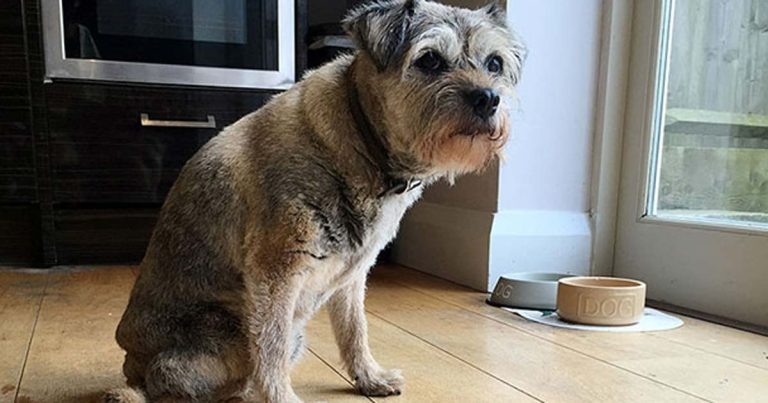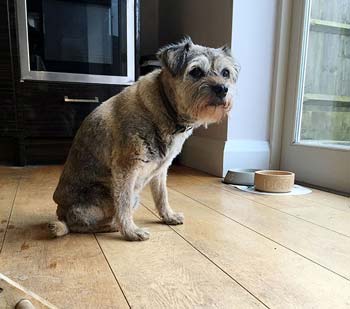8 May 2017
Hannah Capon following on from the first part of this article (VT17.07), suggests how to tackle OA with regards to owner interaction.

Wooden floors can be slippery.
Multimodal is the current buzzword for arthritis management: the use of several different modes of activity to optimally manage OA. It encourages people to combine different modalities, such as NSAIDs with weight management and nutraceuticals or NSAIDs, opioids and physiotherapy, to successfully control pain and slow progression of the disease.
A study by Belshaw et al (2016) highlighted fundamental issues wrong with veterinary management of OA. Owners felt they were not given enough time with the vet to discuss the complex, confusing, and often terminal disease, and found it hard to identify chronic pain in their dog, with the consultation system making it difficult for vets.
A dearth of easily accessible and incorrect information from friends, dog industry workers and online sources is creating preconceived and often false beliefs regarding the disease. A lack of public knowledge and fear exists regarding the side effects of NSAIDs, resulting in poor compliance and inappropriate use.
We have already suggested these statements could be resolved by improving education regarding how chronic pain differs from acute pain, which is what people understand as the pain their dog would feel. We feel this undertaking is huge and could be tackled as a practice through:

But is this enough? Or should we go further by constructing an integrated management plan with the same level of assertiveness we use on owners of diabetic cats or heart failure dogs? Advice in these clinical situations is very assertive, constructive and monitored.
Ross Palmer, diplomate with the American College of Veterinary Surgeons, complemented Zoe Belshaw’s lecture at London Vet Show, using the case study of his neighbour’s dog, and reiterating how effective multimodal management is, but also illustrating the biggest hurdle is communication with, and commitment from, the owner. He laboured how hard initiating change in the owner’s lifestyle and expectations can be, but, when successful, the results can be dramatic.
I have first-hand experience of this and can recall numerous cases that have responded dramatically to constructive, thorough and firm advice. Through a combination of advice regarding imperative lifestyle change, such as home management and exercise – alongside advice regarding further therapies and veterinary intervention – I have seen bewildered owners become the power houses of their dog’s improvement and maintenance.
Through setting up external support service Canine Arthritis Management (www.caninearthritis.co.uk), which visited dogs in their own homes, I learned certain areas of advice referred to in the consult room were imperative to success and should be integrated into every management plan – no option.
I now feel no discomfort labouring this integrated approach to owners as, much to their disbelief, a lot of what is strongly suggested is of minimal cost to implement. House adaptations, exercise regime modifications and weight control cost little to implement and, I feel, are game-changers with regards to long-term management. They also cement an understanding in clients you fully support them with regards to their ageing friend.
As a vet of 15 years, I can recount numerous consults in the past where I delivered exercise control and simple house changes in one breath. It was a mere snippet of a 10-minute consult I congratulated myself at remembering at all. If only I knew then what I know now.
I can confidently say I have not visited any clients’ houses in the past two years where I have not pointed out modifications that will prevent repetitive injuries to dogs. For example, slippery floors. These aren’t a hazard to arthritic dogs – they are, in fact, torture. We all know arthritis causes pain that leads to limb sparing weight carriage, resulting in muscle wasting and soft tissue weakening. This leaves a limb unable to accommodate a minor slip, which can result in a serious fall or repetitive strain injury.
Owners don’t see the 2in slip in the right hindleg that happens countless times per day, as the other three limbs generally compensate and keep the dog standing, although minor soft tissue injury occurs.
Owners would never have thought a floor was slippery, as generally people have sweep clean surfaces for ease of cleaning, and this precludes the need to take off grippy shoes in the house. It could also be argued with improved central heating systems, including under the floor, if the owner not wearing shoes he or she is usually barefoot, which has more grip than an old dog’s hairy feet and worn pads.
An owner sees his or her dog, with its four legs, as being more stable than us bipedal beasts and argue their dog isn’t designed to slip. In the two years I visited owner’s homes to assess their dogs; 95% have a sneaky slippery floor a dog has to negotiate countless times per day.
Another example is stairs. Have you ever laid your chest on a landing perched on the edge of the highest step and looked down at the next 20? It is daunting and dangerous, and often overlooked by an owner as a hazard because his or her dog somehow still does it, if somewhat slower going up and faster coming down. They don’t think the dog has dutifully climbed those stairs every day for the past 12 years to be close to their owner. Why would they give up now?
I would suggest 80% of households I visit allow and encourage their arthritic dog to climb and descend the stairs unaided multiple times daily. These owners are likely to have been told “don’t allow your dog to use the stairs in your house” in a consult a few weeks before. I don’t have to labour the high risk of falls and soft tissue strains this causes, but I will labour that stairs come in all shapes and sizes, and owners will only think of the staircase, not the patio steps, the front door access steps or the steps in the split-level lower floor.
A further example is ball throwing. Without the knowledge chronic pain is different to acute pain, how could we expect an owner to understand the energy and agility their dog shows in the park is going to be discomfort, if not agony, later?
It is common knowledge endorphins are endogenous analgesics working on opioid receptors in the brain, and we know exercise and excitement produce endorphins. Now, let’s add in some serotonin released during compulsive repetitive acts – another known endogenous analgesic. These neurochemicals don’t last and eventually return to normal levels, leaving the arthritic dog unsure why its pain status is sky high.

How do you explain to an owner to break that pleasurable habit keeps him or her assured his or her dog is not really in pain? With difficulty, but it is imperative and will result in lower pain levels, less acute flares and likely delayed/reduced medical intervention. I personally have found it’s best discussing it as “happy, short-term brain juice”.
Many management observations are regularly noted by house visits, all of which hinder pain control and slow the progression of the disease. I cannot defend the statement house management and exercise modification is an analgesic equivalent to an NSAID, but I would love to prove it, as these changes are hugely effective and need to be integrated into a management plan.
So, could you upgrade your practice’s multimodal approach to arthritis in dogs to an integrated management plan? In reality, I feel from working in the field for the past three years this can only be tackled as an external service that enters an owner’s home for at least the initial consult. However, I do think good instruction, well laid out, image-filled handouts, or online access and attention to detail can fill a much-needed gap.